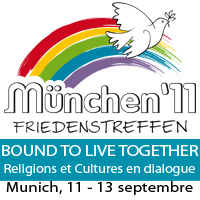Kikahosshoshou Buddhist Temple, Japan
|
My name is Eigen Onishi from Kiyomizudera Temple in Kyoto, Japan. I feel humbled by this wonderful opportunity and greatly appreciate the chance to be a member of this panel. First of all, I would truly like to thank everyone for the contributions, warm regards, dedication, donations and praying that Japan has received from all over the world.
Over 15 thousand lives have been lost, 48 hundred are still missing and about 88 thousand people have been displaced. In addition, more than 250 thousand buildings were damaged.
I am going to talk about two things. One is about the reaction of Japanese people to this terrible disaster and the other is about the role of religion in dealing with the aftermath.
In terms of the reaction of Japanese people, there were so many who positively contributed and were dedicated to helping hands. Meanwhile, some felt obligated, some were passive and others were actually indifferent. Because of more pressure by official and private businesses, more trends towards the independent family and the variety of crimes, there was less compassion and sympathy towards others from the Japanese mentality. However, it was surprising that there was greater support than could have been imagined based on this Japanese mentality.
Not one day has gone by without hearing the news about various supports, charity from celebrities, sports players, companies, groups and individuals. Over 3 billion U.S. dollars has already been sent to the stricken area through Japanese Red Cross. Of course, there have been lots of other donations and help through different groups.
For those who didn’t directly suffer from the earthquake, their memories will unconsciously fade with time. However, the revival of the area is such a long way off that nothing should be forgotten. There are still many problems, such as the nuclear power plant, mental care for people who can hardly find any hope and a higher risk of suicide. We all have to keep making an effort and doing what we can, in other words, continued dedication and contributions are absolutely essential.
As for the role of religion, I am going to introduce three categories. The first is praying for all the casualties, meaning all of their souls. Traditionally, in Japanese culture, people live their lives respecting the souls of the dead. They have a family altar in their houses, go to the tombs of our ancestors quite often and have an official ceremony to welcome the souls of our ancestors once a year. In this culture, there is a big role which religion is expected to play by holding a service for the departed souls in this disaster.
The second is material and humanitarian assistance called “Fuse-Gyou.” It is supposed to be done based on “Jihi” which translates into mercy and compassion actually meaning taking away suffering and giving happiness in Buddhism. “Jihi” is similar to “Love” in Christianity. In Buddhism, we should all consider ourselves as the irreplaceable. So, we also should consider others as irreplaceable as ourselves and treat them like we wish to be treated. Needless to say, more assistance and help is required in the stricken area and religion can help.
Finally, religion is supposed to help people cultivate their views of life and death. There are fewer occasions to spend time with people who are passing away on account of improvement in the medical field, safety, sanitation and trends towards the independent family. When we are blessed with life for the first time, we know we will have to pass away someday. Buddhism preaches that nothing is permanent. While we are fine and healthy, we can hardly take that for granted. There are lots of socially and religiously controversial matters related to views of life and death, such as abortion, terminal care, brain death, organ transplantation and mercy killing. However, there are not many who deal with these matters on their own.
Death is painful suffering and separation from all of social and human relationships. Buddhism preaches that death is one of the most painful sufferings, and life is also one of them because it leads to death sooner or later. Nobody knows when their death will come. It might be sudden or someday later. Therefore, it is important to cultivate views of life and death and religion can help to develop this.
For example, a patient suffering from terminal cancer decides not to spend the rest of his time for medical care but for self enrichment. This decision comes from his view of life and death. In order to accept death with courage, hope and blessing, it is significant to find the meaning of life. It should be true appreciation for bonds and trust in relationships we have created, and for life itself we have received.
Cultivating views of life and death is to seek the meaning of life, and true appreciation for all. In other words, we should ultimately make the most of this time, which could be in common for all religion. Likewise, this terrible disaster gives us an unforgettable lesson which we all have to reconsider. |

